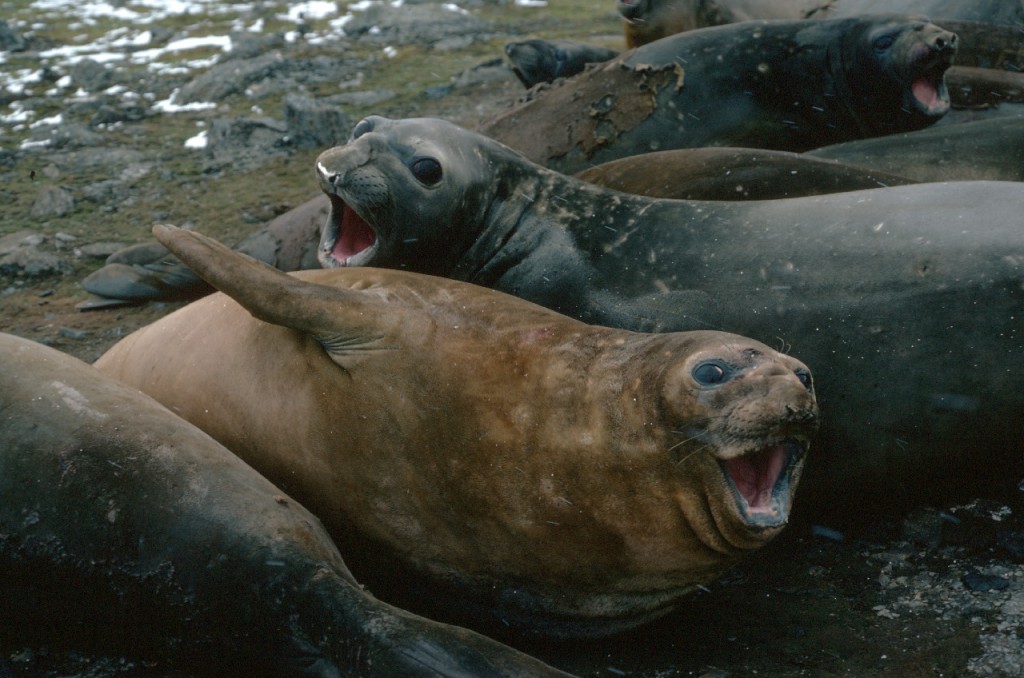
New technology has allowed an international team including UK scientists from University of St Andrews and British Antarctic Survey to witness for the first time the behaviour of the southern elephant seal (Mirounga leonina) and how it relates to its physical environment. Small sensors were attached to 85 seals to track their movements and collect data about their marine environment. Results are published this week in the journal Proceedings of the National Academy of Sciences.
The seals were tagged at the islands of South Georgia, Kerguelen and Macquarie in the Southern Ocean, and at the western coast of the Antarctic Peninsula. The data from the seals was transmitted back to land via satellite and shows that elephant seals adopted different strategies to find food.
The Sea Mammal Research Unit at St Andrews University led the research. Author Mike Fedak says, “These data are really exciting. This new technology has allowed us to see where the seals go and understand their behaviour in the context of different characteristics of water in the Southern Ocean. The majority of animals from South Georgia fed within the Antarctic Circumpolar Current, but seals from other locations had a very different strategy, and visited colder waters nearer the continental shelf.
He added, “This approach helps us to understand current population trends, where the animals forage and predict the availability of food under various climate change scenarios.”
Dr. Mike Meredith, Head of the Atmosphere and Ocean Group at British Antarctic Survey says, “The Southern Ocean is the hardest place in the world to obtain oceanographic data, especially during the wintertime. The seals acted as ‘samplers’ to collect data from deep seas that we couldn’t ordinarily access due to their remoteness and harsh environments. Understanding how these animals respond to their environment is fundamental in predicting how they may respond to climate change and the consequent shifts in ocean circulation and ice dynamics.”
Issued jointly by British Antarctic Survey and University of St. Andrews Press Office
British Antarctic Survey:
Athena Dinar tel: ++44 (0) 1223 221414, mobile: 07740 822229 email: a.dinar@bas.ac.uk
Linda Capper tel: ++44 (0) 1223 221448, mobile 07714 233744 email l.capper@bas.ac.uk or
St Andrews University:
Gayle Cook tel: ++44 (0) 1334 462530, mobile: 07900 050103 email: gec3@st-andrews.ac.uk
Authors:
Dr. Martin Biuw, Sea Mammal Research Unit tel. ++44 (0) 1334 462677 email: emb7@st-andrews.ac.uk
Mike Fedak, Sea Mammal Research Unit tel. ++44 (0) 1334 463218 email: maf3@sea-mammal-research-unit.st-andrews.ac.uk
Dr Mike Meredith, British Antarctic Survey tel. ++ 44 (0) 1223 221586, email: m.Meredith@bas.ac.uk
This research involved biologists and oceanographers from the following Institutes:
Gatty Marine Laboratory, Sea Mammal Research Unit @ St Andrews University (UK)
Centre d’Etudes Biologiques de Chize (France)
Antarctic Wildlife Research, School of Zoology (Hobart)
Center for Ocean Health, Institute of Marine Sciences (USA)
Laboratoire d’Oceanographie Physique Museum National d’Histoire Naturelle (France)
British Antarctic Survey (UK)
Commonwealth Scientific and Industrial Research Organisation (Hobart)
Antarctic Co-operative Research Centre @ University of Tasmania (Hobart)
Antarctic Ecosystem Research Division @ National Oceanic and Atmospheric Administration (USA)
Valeport Ltd (UK)
Notes for Editors:
Stills of elephant seals with the sensors are available from the press offices above. Footage of elephant seals at South Georgia is available from the BAS Press Office.
The research was funded by the Natural Environment Research Council.
The sensors, the size of a pack of cards, were attached to the head of elephant seals. The device is attached with glue but falls off when the seals moult. They are small devices for such large and powerful animals, and have no impact.
The sensors ‘conductivity-temperature-depth satellite relay data logger’ (CTD-SRDL) provides high accuracy temperature and salinity readings via satellite. They were designed and built by the NERC Sea Mammal Research Unit and Valeport Ltd UK.
The Southern Ocean is one of the most productive of the world’s oceans, mainly a result of short, intensive spring phytoplankton blooms.
The majority of the seals from South Georgia remained in the Antarctica Circumpolar Current avoiding Antarctic waters such as the Weddell Sea, whereas seals from other locations favoured waters much closer to the Antarctic continent. Regions of upwelling of nutrient-rich deep waters were clearly favoured.
Sea temperature is predicted to increase by around 2°C in the next 100 years. If Antarctic animals can’t adapt, they are unlikely to be able to cope in warmer water, or compete with species that will inevitably move into the region as temperatures rise.
The NERC Sea Mammal Research Unit is a NERC Collaborative Centre that provides the UK’s main science capability in the field of marine mammal biology. One of its core objectives is to understand the causes and consequences of change in marine mammal populations. It has been a leader in the development of new ways to study marine mammals and has applied its expertise in projects worldwide. www.smru.st-and.ac.uk
British Antarctic Survey is a world leader in research into global issues in an Antarctic context. It is the UK’s national operator and is a component of the Natural Environment Research Council. It has an annual budget of around £40 million, runs nine science programmes and operates five research stations, two Royal Research Ships and five aircraft in and around Antarctica. More information about the work of the Survey can be found at: www.antarctica.ac.uk
